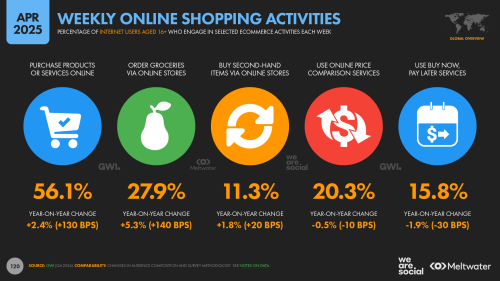Social Media Impact in Shopping
In recent years, the influence of social media on consumer purchasing decisions has intensified significantly, establishing itself as a powerful driver in the shopping landscape. The emergence of platforms like Instagram, Facebook, and Pinterest has transformed the way consumers explore products, engage with brands, and ultimately make purchasing decisions. A striking statistic highlights this trend: approximately 76% of social media users are inclined to buy products they discover through social media content. This figure underscores the potency of social media as an influential platform that shapes consumer behavior.
Consumers are increasingly relying on social media not only for entertainment but also for product discovery and brand engagement. Engaging posts, influencer collaborations, and targeted advertisements play a crucial role in attracting potential buyers. As shoppers scroll through their feeds, they are often inspired by visually appealing content, reviews from fellow users, and direct recommendations from trusted influencers. This behavioral shift indicates a move toward a more interactive shopping experience, where social media acts as a bridge connecting consumers to brands.
Moreover, the power of social media lies in its ability to provide users with a sense of community and immediate feedback. Shoppers are more likely to trust peer recommendations over traditional advertising, leading brands to leverage this dynamic through strategic social media marketing. By creating authentic and relatable content, brands can foster genuine connections with their audience, paving the way for increased sales. The rise in user-generated content and online reviews further amplifies the credibility of products displayed on these platforms, resulting in a notable shift in purchasing behavior.
As businesses recognize the importance of this trend, many are adapting their marketing strategies to include impactful social media campaigns aimed at enhancing consumer engagement. In a marketplace where convenience and accessibility are key, understanding the role of social media in influencing purchasing decisions is paramount for brands striving to thrive in an increasingly competitive environment.
The Statistics Behind Social Media Purchases
The relationship between social media interactions and consumer purchasing decisions has become a focal point of research, revealing compelling statistics that highlight its significance. A study conducted by Pew Research indicates that a striking 76% of social media users have reported intentions to make purchases influenced by content they encountered on these platforms. This statistic underscores the growing impact of social media on modern consumer behavior.
Collecting these statistics typically involves large-scale surveys and data analysis, wherein researchers study user interactions across various social networks. The objective is to quantify how often users engage with brands through likes, shares, and comments, and to ascertain whether these interactions lead to actual purchases. This considerable engagement suggests that social media serves not merely as a marketing vehicle but as a critical component of the consumer journey.
Furthermore, additional insights gathered from various studies reveal that younger demographics, particularly millennials and Gen Z, are more influenced by social media when making purchases. These age groups show a higher tendency to rely on peer reviews, influencer endorsements, and targeted advertising found in their social feeds. Such findings point to a shifting landscape where traditional marketing tactics are increasingly supplemented, or in some cases supplanted, by social media strategies.
This trend is further illustrated by data showing that consumers often turn to social media as a discovery platform for new products. In fact, many individuals report that they have previously purchased items directly as a result of seeing them promoted on social media channels. This highlights the potential for brands to effectively leverage their social media presence to influence purchasing behavior in a measurable way. Overall, the statistics gathered on social media purchases reveal a complex yet undeniably influential dynamic that shapes how consumers approach their buying decisions today.

Visual Content: The Most Effective Form of Engagement
In the realm of social media, visual content has emerged as a critical component of engaging consumers and influencing their purchasing decisions. Research consistently indicates that posts featuring images and videos garner higher engagement rates compared to text-based content. For brands seeking to capture attention and encourage faster purchasing decisions, leveraging visually appealing content is no longer optional; it is essential.
Studies have demonstrated that consumers are more likely to remember information presented visually than through pure text. Visuals evoke emotions and can convey messages more succinctly, prompting quicker reactions. For instance, when consumers encounter a compelling image or an engaging video, they are often drawn to explore a product further. This emotional connection created through aesthetics significantly reduces the time it takes for individuals to decide on a purchase, as the visuals often encapsulate the product’s value and application in everyday life.
Moreover, the aesthetics of visual content play a critical role in attracting and retaining consumer interest. Quality imagery that showcases products in appealing contexts can enhance perceived value and desirability. Brands utilizing strong visual storytelling techniques, including color schemes, layouts, and overall composition, can considerably increase their effectiveness in influencing consumer behavior. Additionally, social media algorithms tend to favor visually-oriented posts, thereby amplifying their reach and engagement potential.
As consumers become inundated with information and options, the visual appeal of posts stands out in a crowded marketplace. The integration of captivating images and engaging videos into marketing strategies is essential for brands wanting to connect with their audience meaningfully. By prioritizing visual content, businesses can harness the power of aesthetic engagement to drive purchasing decisions and foster brand loyalty among consumers.
The Role of Influencer Marketing
In recent years, influencer marketing has emerged as a powerful tool within the social media landscape, significantly impacting consumer purchasing decisions. This strategy involves collaborating with individuals who have established credibility and a substantial following on platforms like Instagram, Twitter, and YouTube. By utilizing influencers, brands can effectively tap into their audiences, gaining access to potential consumers who are already engaged and interested in relevant content.
The primary benefit of influencer marketing lies in its ability to create authentic connections between brands and consumers. Influencers often curate their content to resonate with their followers, which fosters trust and loyalty. This organic relationship means that endorsements from influencers can appear less commercial and more relatable, thereby enhancing brand credibility. Consumers are more likely to respond positively to recommendations from individuals they admire or relate to, rather than traditional advertisements that may come across as pushy or insincere.
Moreover, influencer collaborations can also assist brands in reaching specific target demographics that might otherwise be difficult to engage. Different influencers cater to unique niche markets, allowing brands to tailor their marketing strategies effectively. By aligning with an influencer who matches their brand ethos, companies can yield better results in terms of visibility and engagement.
In addition, influencer marketing campaigns often leverage the social aspect of platforms like Instagram, where sharing and interaction are fundamental. The ripple effect created by a single endorsement can significantly amplify a brand’s reach, as followers are encouraged to share content, leading to wider exposure. As consumer trust in social media continues to grow, influencer marketing demonstrates a compelling way to foster brand awareness while driving purchasing behavior.
Case Studies: Successful Brands Leveraging Social Media
In recent years, several brands have adeptly harnessed the power of social media to influence consumer purchasing decisions, effectively contributing to the 76% trend observed among modern buyers. One notable example is the athletic brand Gymshark, which has seen exponential growth largely due to its robust presence on platforms like Instagram and TikTok. Gymshark capitalized on influencer marketing by collaborating with fitness enthusiasts and trainers who align with its brand values, resulting in increased brand visibility and significant sales boosts. Gymshark’s strategy focused on community building, promoting user-generated content, and engaging with followers through challenges and workouts, ultimately creating a loyal customer base.
Another prominent case is that of Glossier, a beauty brand that has reshaped how cosmetics companies engage with their audiences. Glossier’s approach emphasizes direct feedback from customers, making them integral to the product development process. Through social platforms, Glossier launched specific campaigns allowing users to share their beauty stories and product experiences. This strategy not only elevated user engagement but also provided valuable insights into consumer preferences, leading to a targeted product line that resonates well with its audience. The success of Glossier illustrates the effectiveness of listening to customers as a means of driving sales and enhancing brand loyalty.
Moreover, Nike’s “Dream Crazy” campaign serves as a powerful example of leveraging social media to shape brand identity and consumer perceptions. By featuring empowering narratives, including that of Colin Kaepernick, Nike connected emotionally with its audience, resulting in both controversy and significant sales growth. The campaign was amplified through social media channels, allowing customers to share their own stories and connect with the brand on a deeper level. This case underscores the importance of aligning brand messaging with social values to resonate with conscientious consumers.
These case studies collectively highlight strategic approaches that brands can adopt. By identifying key influencers, fostering community engagement, and aligning with social causes, companies can effectively leverage social media to drive sales and enhance consumer connection.
Choosing the Right Digital Marketing Agency
Selecting an appropriate digital marketing agency is crucial for brands aiming to navigate the complexities of social media dynamics effectively. With the rapidly evolving landscape, companies must partner with agencies that not only understand the latest trends but can also create tailored, engaging content that resonates with target audiences. To achieve this, businesses should consider several key criteria when evaluating potential agencies.
Firstly, it is essential to assess the agency’s experience and expertise in social media marketing. An agency that specializes in digital marketing should be familiar with various platforms, trends, and consumer behaviors. This specialized knowledge enables them to craft targeted marketing strategies that align with the brand’s objectives and audience preferences. Additionally, reviewing case studies and client testimonials can provide insights into the agency’s past performance and success in driving consumer engagement through social media.
Furthermore, communication is a vital factor in the agency-client relationship. Brands should seek an agency that prioritizes transparency and maintains open lines of communication throughout the engagement. This ensures that the brand’s voice and vision are accurately represented in the social media campaigns. Regular updates and collaborative brainstorming sessions can create a partnership that unlocks creative potential and enhances marketing effectiveness.
Lastly, alignment with the target audience is paramount. A proficient digital marketing agency must conduct comprehensive market research to understand the demographics, preferences, and behaviors of the audience. This knowledge enables them to create customized content that speaks directly to consumers, ultimately influencing their purchasing decisions. Investing time and resources into selecting the right agency is critical, as it can lead to a significant impact on consumer engagement and purchasing behavior.
Conclusion: Embracing Social Media for Future Growth
As we have explored throughout this discussion, social media significantly influences consumer purchasing decisions, with research indicating that approximately 76% of consumers are swayed by social media interactions when making buying choices. This trend underscores the necessity for brands to understand the dynamic landscape of digital engagement and consumer behavior. It is no longer sufficient for businesses to maintain a passive online presence; rather, they must actively participate and adapt to the evolving preferences of their target audience in the digital domain.
To harness the power of social media effectively, brands should consider implementing innovative strategies that capitalize on the vast potential of these platforms. Engaging with influencers can amplify a brand’s message, as these individuals have established trust and credibility with their followers. By collaborating with such influencers, brands can not only reach a wider audience but also create authentic connections that resonate with potential customers.
Moreover, it is imperative for businesses to stay attuned to the latest trends and consumer preferences on social media. The digital-first world continuously evolves, and what works today may not be effective tomorrow. Regularly analyzing social media metrics and consumer feedback can provide invaluable insights that guide marketing strategies, ensuring that brands remain relevant and impactful in their outreach efforts.
In conclusion, embracing social media as a core component of a business strategy can yield significant benefits for brands seeking to influence purchasing behavior. By fostering genuine engagement, leveraging influencers, and maintaining flexibility in response to shifting consumer dynamics, businesses can thrive in this interconnected marketplace. Embracing these evolving social media strategies will undoubtedly pave the way for future growth and success in a rapidly changing environment.


